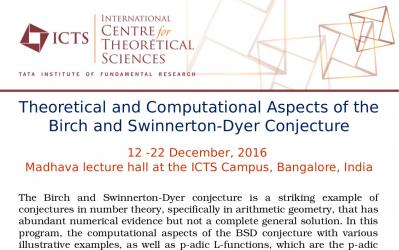The Birch and Swinnerton-Dyer conjecture is a striking example of conjectures in number theory, specifically in arithmetic geometry, that has abundant numerical evidence but not a complete general solution. An elliptic curve, say E, can be represented by points on a cubic equation as below with certain A, B ∈ Q:
y2 = x3 + Ax +B
A Theorem of Mordell says that that E(Q), the set of rational points of E, is a finitely generated abelian group, and thus,
E(Q) = Zr ⊕ T,
for some non-negative integer r and a finite group T. Here, r is called the algebraic rank of E.
The Birch and Swinnerton-Dyer conjecture relates the algebraic rank of E to the value of the L-function, L(E, s), attached to E at s = 1.
Further theoretical understanding, corroborated by computations lead to a stronger version of the BSD conjecture. This refined version of the BSD conjecture provides a very precise formula for the leading term of L(E, s) at s = 1, the coefficient of (s − 1)r, in terms of various arithmetical data attached to E. Thus, the computational side of the BSD conjecture goes hand in hand with the advanced concepts in the theory of Elliptic curves.
In this program, the computational aspects of the BSD conjecture with various illustrative examples, as well as p-adic L-functions, which are the p-adic analogues of the L-functions and other theoretical aspects which are important for the BSD conjecture will be discussed.
 icts
icts res
res in
in

